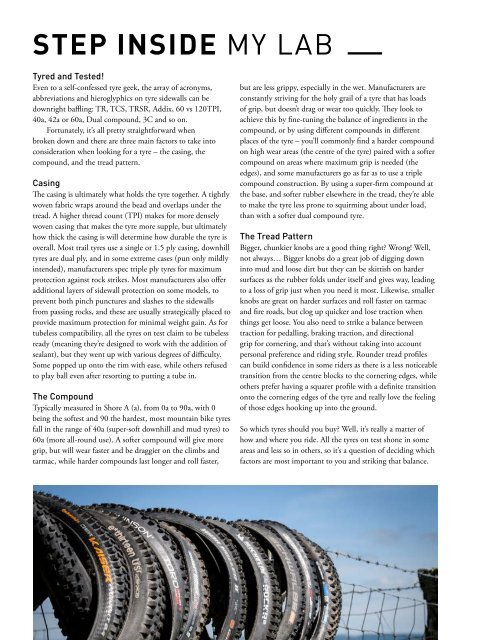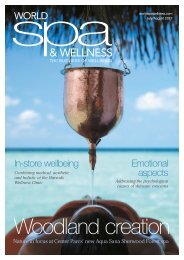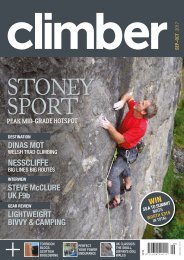Singletrack
Create successful ePaper yourself
Turn your PDF publications into a flip-book with our unique Google optimized e-Paper software.
STEP INSIDE MY LAB<br />
Tyred and Tested!<br />
Even to a self-confessed tyre geek, the array of acronyms,<br />
abbreviations and hieroglyphics on tyre sidewalls can be<br />
downright baffling: TR, TCS, TRSR, Addix, 60 vs 120TPI,<br />
40a, 42a or 60a, Dual compound, 3C and so on.<br />
Fortunately, it’s all pretty straightforward when<br />
broken down and there are three main factors to take into<br />
consideration when looking for a tyre – the casing, the<br />
compound, and the tread pattern.<br />
Casing<br />
The casing is ultimately what holds the tyre together. A tightly<br />
woven fabric wraps around the bead and overlaps under the<br />
tread. A higher thread count (TPI) makes for more densely<br />
woven casing that makes the tyre more supple, but ultimately<br />
how thick the casing is will determine how durable the tyre is<br />
overall. Most trail tyres use a single or 1.5 ply casing, downhill<br />
tyres are dual ply, and in some extreme cases (pun only mildly<br />
intended), manufacturers spec triple ply tyres for maximum<br />
protection against rock strikes. Most manufacturers also offer<br />
additional layers of sidewall protection on some models, to<br />
prevent both pinch punctures and slashes to the sidewalls<br />
from passing rocks, and these are usually strategically placed to<br />
provide maximum protection for minimal weight gain. As for<br />
tubeless compatibility, all the tyres on test claim to be tubeless<br />
ready (meaning they’re designed to work with the addition of<br />
sealant), but they went up with various degrees of difficulty.<br />
Some popped up onto the rim with ease, while others refused<br />
to play ball even after resorting to putting a tube in.<br />
The Compound<br />
Typically measured in Shore A (a), from 0a to 90a, with 0<br />
being the softest and 90 the hardest, most mountain bike tyres<br />
fall in the range of 40a (super-soft downhill and mud tyres) to<br />
60a (more all-round use). A softer compound will give more<br />
grip, but will wear faster and be draggier on the climbs and<br />
tarmac, while harder compounds last longer and roll faster,<br />
but are less grippy, especially in the wet. Manufacturers are<br />
constantly striving for the holy grail of a tyre that has loads<br />
of grip, but doesn’t drag or wear too quickly. They look to<br />
achieve this by fine-tuning the balance of ingredients in the<br />
compound, or by using different compounds in different<br />
places of the tyre – you’ll commonly find a harder compound<br />
on high wear areas (the centre of the tyre) paired with a softer<br />
compound on areas where maximum grip is needed (the<br />
edges), and some manufacturers go as far as to use a triple<br />
compound construction. By using a super-firm compound at<br />
the base, and softer rubber elsewhere in the tread, they’re able<br />
to make the tyre less prone to squirming about under load,<br />
than with a softer dual compound tyre.<br />
The Tread Pattern<br />
Bigger, chunkier knobs are a good thing right? Wrong! Well,<br />
not always… Bigger knobs do a great job of digging down<br />
into mud and loose dirt but they can be skittish on harder<br />
surfaces as the rubber folds under itself and gives way, leading<br />
to a loss of grip just when you need it most. Likewise, smaller<br />
knobs are great on harder surfaces and roll faster on tarmac<br />
and fire roads, but clog up quicker and lose traction when<br />
things get loose. You also need to strike a balance between<br />
traction for pedalling, braking traction, and directional<br />
grip for cornering, and that’s without taking into account<br />
personal preference and riding style. Rounder tread profiles<br />
can build confidence in some riders as there is a less noticeable<br />
transition from the centre blocks to the cornering edges, while<br />
others prefer having a squarer profile with a definite transition<br />
onto the cornering edges of the tyre and really love the feeling<br />
of those edges hooking up into the ground.<br />
So which tyres should you buy? Well, it’s really a matter of<br />
how and where you ride. All the tyres on test shone in some<br />
areas and less so in others, so it’s a question of deciding which<br />
factors are most important to you and striking that balance.<br />
100






